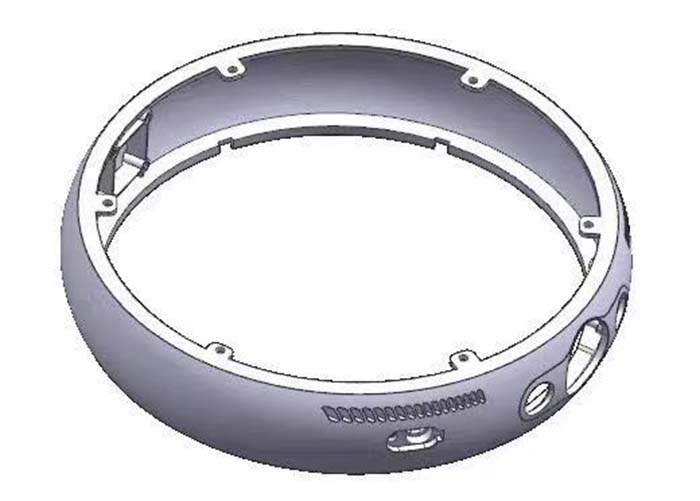What are the injection molding defects?
The phenomena and solutions of various injection molding defects refer to the phenomenon and corresponding solutions of cracks, insufficient filling, wrinkles, pockmarked surfaces, shrinkage pits, overflow, etc.
Injection Molding Defect 1. Cracking
Cracking is a common defect in plastic products, and the main cause is due to stress and deformation. There are mainly residual stress, external stress, and stress deformation caused by the external environment.
(1) Cracks caused by residual stress
The residual stress is mainly caused by the following three conditions, namely, overfilling, ejection from the mold, and metal inserts. As the cracks produced in the case of overfilling, the solution can be mainly in the following aspects.
1) Since the pressure loss of the sprue is the smallest if the cracks are mainly generated near the sprue, you can consider switching to the multi-point distribution point gate, side gate, and shank gate method.
2) On the premise of ensuring that the resin does not decompose or deteriorate, appropriately increasing the resin temperature can reduce the melt viscosity and improve the fluidity, and at the same time, it can also reduce the injection pressure to reduce the stress.
3) Under normal circumstances, the mold temperature is easy to produce stress when the mold temperature is low, so the temperature should be increased appropriately. But when the injection speed is higher, even if the mold temperature is lower, the stress generation can be reduced.
4) Too long injection and holding pressure time will also produce stress, it is better to shorten it appropriately or perform Th times holding pressure switching.
5) Non-crystalline resins, such as AS resin, ABS resin, PMMA resin, etc., are more likely to produce residual stress than crystalline resins such as polyethylene, polyoxymethylene, etc., so attention should be paid.
When demolding and pushing out, due to the small demolding angle, the mold rubber, and the roughness of the punch, the pushing force is too large, causing stress, and sometimes even whitening or cracking occurs around the pushing rod. As long as you carefully observe the location of the cracks, you can determine the cause.
When inserting metal parts during injection molding, stress is most likely to occur, and cracks are likely to occur after a period, which is extremely harmful. This is mainly due to the large difference between the thermal expansion coefficients of metal and resin, which produces stress, and over time, the stress exceeds the strength of the gradually degraded resin material to cause cracks. To prevent the resulting cracks, as an experience, the wall thickness is 7″ and the outer diameter of the embedded metal part
General-purpose polystyrene is basically not suitable for adding inserts, and inserts have the least impact on nylon. Because glass fiber-reinforced resin material has a small thermal expansion coefficient, it is more suitable for inserts.
In addition, preheating the metal insert before molding also has a good effect.
(2) Cracks caused by external stress
The external stress here is mainly due to stress concentration caused by unreasonable design, especially at sharp corners.
(3) Cracks caused by the external environment
Chemicals, water degradation caused by moisture absorption, and excessive use of recycled materials will deteriorate physical properties and cause cracks.
Injection Molding Defect 2. Insufficient filling
The main reasons for insufficient filling are as follows.
Insufficient resin capacity; Insufficient pressurization in the cavity; Insufficient resin fluidity; The exhaust effect is not good.
As an improvement measure, we can mainly start from the following aspects.
1) Lengthen the injection time to prevent the resin from flowing backward before the gate is cured due to the short molding cycle, and it is difficult to fill the cavity.
2) Increase the injection speed.
3) Increase the mold temperature.
4) Increase the resin temperature.
5) Increase the injection pressure.
6) Expand gate size. Generally, the height of the gate should be equal to 1/2~l/3 of the wall thickness of the product.
7) The gate is set at the largest wall thickness of the product.
8) Set up exhaust groove (average depth 0.03mm, width 3~SMM) or exhaust rod. It is more important for smaller parts.
9) Leave a certain (about SMM) buffer distance between the screw and the injection nozzle.
10) Choose low-viscosity-grade materials.
11) Add lubricant.
Injection Molding Defect 3. Wrinkle strokes and pockmarked noodles
The reason for this defect is essentially the same as the underfilling, but the degree is different. Therefore, the solution is the same as the above method. Especially for resins with poor fluidity (such as polyoxymethylene, PMMA resin, polycarbonate, PP resin, etc.), more attention should be paid to appropriately increasing the gate and appropriate injection time.
Injection Molding Defect 4. Shrink pit
The reason for shrinkage pits is also the same as insufficient filling. In principle, it can be solved by excess filling, but there is a danger of stress. The design should pay attention to uniform wall thickness, and reduce the reinforcement ribs, convex pillars, and other places wall thickness as much as possible.
Injection Molding Defect 5. Overflow
The focus of the overflow treatment should be mainly on the improvement of the mold. In terms of molding conditions, you can start to reduce fluidity.
Specifically, the following methods can be used, lower the injection pressure and lower the temperature of the heating barrel. Reduce injection speed; etc.
You may also be interested in the below articles.
Summary Of 50 Injection Mold Structure Operation Dynamic Diagrams
Auto Parts Stamping Die Design Concept




